Brazilian cruzeiro (1942–1967)
This article needs additional citations for verification. (August 2021) |
This article may be expanded with text translated from the corresponding article in Portuguese. (July 2021) Click [show] for important translation instructions.
|
| Cruzeiro (1942–1967) | |
|---|---|
 Example of a 5 cruzeiro note from 1963, portraying the bust of Barão do Rio Branco on the obverse | |
| Denominations | |
| Subunit | |
| 1⁄100 | centavo |
| Plural | cruzeiros |
| centavo | centavos |
| Symbol | ₢$ (also Cr $, Cr$, Cr, etc.) |
| Banknotes | ₢$1, ₢$2, ₢$5, ₢$10, ₢$20, ₢$50, ₢$100, ₢$200, ₢$500, ₢$1,000, ₢$5,000, ₢$10,000 |
| Coins | ₢$0,10, ₢$0,20, ₢$0,50 ₢$1, ₢$2, ₢$10, ₢$20, ₢$50 |
| Demographics | |
| Date of introduction | 1 November 1942 |
| Source | [1] |
| Replaced | Real |
| Date of withdrawal | 13 February 1967 |
| Source | [2] |
| Replaced by | Cruzeiro novo |
| User(s) | Brazil |
This infobox shows the latest status before this currency was rendered obsolete. | |
The (first) cruzeiro (₢$) was the official currency of Brazil from 1942 to 1967.[1] It replaced the old real (pl. réis), which had been in use since colonial times, at the rate of RS1$000 = ₢$1, It was in turn replaced by the cruzeiro novo, at the rate of ₢$1,000 = NCr$1.[2]
The name cruzeiro was later reused for two other currencies, which were official in and 1990–1993.
The cruzeiro was divided into 100 fractional units called centavos, a convention that persisted through all subsequent Brazilian currencies.
History[]
Since colonial times, the main currency in Brazil had been the real; first the same as the Portuguese currency, and a separate currency after the country's independence in 1822.
On 1 November 1942 the real was replaced by a new currency, the "cruzeiro", officially worth 1000 réis (mil réis, pronounced mirréis) — which had long been used informally as the currency unit for most retail trades. The old réis banknotes and coins remained in use for a while.[1] Some were overstamped with the amount in cruzeiros. New cruzeiro banknotes were printed starting in 1943.

By 1967 devaluation (inflation) of the cruzeiro had rendered prices unwieldy, so on 13 February 1967 the military government decreed its replacement by a new currency, the Cruzeiro novo (NCr$), at the rate of NCr$1 = ₢$1000.[2]
Name[]
The name refers to the constellation of the Southern Cross, known in Brazil as Cruzeiro do Sul, or simply Cruzeiro.[3] Prominently visible in the southern hemisphere, it is a major cultural icon in Brazilian history. It is used in a number of Brazilian states' flags, was part of companies' logotypes (like former Sudameris bank or flight company Cruzeiro do Sul) and also gave the name of Cruzeiro Esporte Clube, one of the main Brazilian soccer teams.
The name cruzeiro for the Rs1$000 was proposed in 1926, by Brazilian economist (1882–1948).[citation needed] The first editorial of the Brazilian weekly magazine Cruzeiro apparently refers to this proposal as an alleged inspiration for its name.[4][5]
Symbol[]
The cruzeiro broke with Portuguese and Brazilian traditions for the writing of currency amounts. Instead of using the double-stroke dollar sign (cifrão) as a thousands separator (as was the practice with reais) or as the decimal fraction separator (as Portugal adopted when it switched to the escudo and centavos), the cruzeiro followed its traditional notation for numbers in general, with period (".") and comma (",") used for those two functions, respectively.
The dollar sign was retained, but as part of the new currency symbol "Cr $" (two separate letters and a single-stroke dollar sign, with a space before the latter, to be written before the number, "whatever its amount".[1] However, in subsequent years the two-stroke variant of the sign was often used too, and the space was usually omitted.[6] Also, some typewriters and typefaces provided a typographic ligature "₢" (available in Unicode) to replace the "Cr".
Coins[]
Six denominations of coins were introduced in 1942: 10, 20 and 50 centavos, and ₢$1, ₢$2 and ₢$5. The centavos were initially struck in cupronickel, switching to aluminium bronze in 1943, whilst the cruzeiros were struck in aluminium bronze from the start. The ₢$5 was not struck after 1943.
| Reverse | Obverse | Value | Minting period | Obverse description |
|---|---|---|---|---|
 |
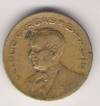 |
₢$0.10 | 1942–1947 | Portrays Getúlio Vargas |
 |
 |
₢$0.20 | 1942–1948 | |
 |
 |
₢$0.50 | 1942–1947 | |
 |
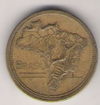 |
₢$1 | 1942-1956 | Portrays a relief map of Brazil |
 |
 |
₢$2 | ||
 |
 |
₢$5 | 1942–1943 |
Following the end of the Vargas Era, in 1947 and 1948 replacements for the 10, 20 and 50 centavos coins were issued that did not portray Getúlio Vargas on the obverse. The new designs featured busts of proeminent Brazilian people, along with the new president, Dutra.
| Reverse | Obverse | Value | Minting period | Obverse description |
|---|---|---|---|---|
 |
 |
₢$0.10 | 1947–1955 | Portrays José Bonifácio |
 |
 |
₢$0.20 | 1948–1956 | Portrays Ruy Barbosa |
 |
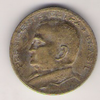 |
₢$0.50 | 1948–1956 | Portrays Eurico Gaspar Dutra |
A few more designs were later introduced in 1956 and 1957, which eventually made aluminium replace aluminium bronze in all the coins.
| Reverse | Obverse | Value | Minting period | Obverse description |
|---|---|---|---|---|
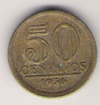 |
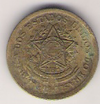 |
₢$0.50 | 1956 | Portrays the coat of arms of Brazil |
 |
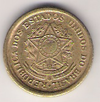 |
₢$1 | ||
 |
 |
₢$2 | ||
 |
 |
₢$0.10 | 1956–1961 | |
 |
 |
₢$0.20 | ||
 |
 |
₢$0.50 | 1957–1961 | |
 |
 |
₢$1 | ||
 |
 |
₢$2 |
Coinage stopped production in 1961, restarting in 1965 with aluminium ₢$10 and ₢$20 coins, and cupronickel ₢$50 coins. In 1964, the "centavo" coins were withdrawn, and the other coins were withdrawn between 1967 and 1968.
| Reverse | Obverse | Value | Minting period | Obverse description |
|---|---|---|---|---|
 |
 |
₢$10 | 1965 | Portrays a relief map of Brazil |
 |
 |
₢$20 | ||
 |
 |
₢$50 | Portrays the effigy of the Republic |
Banknotes[]
The first banknotes were overprints on earlier mil réis notes, with denominations of ₢$5, ₢$10, ₢$20, ₢$50, ₢$100, ₢$200 and ₢$500. Regular issues of cruzeiro banknotes began in 1943 with the addition of ₢$1,000 notes. ₢$1 and ₢$2 notes were introduced in 1944 and ceased production after 1958.
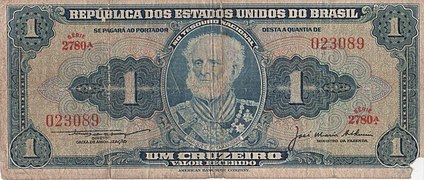
₢$1 note, featuring Joaquim Marques Lisboa

₢$2 note, portraying Duque de Caxias
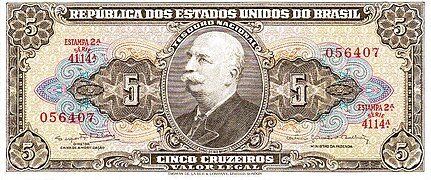
₢$5 note, portraying Barão do Rio Branco

In 1963, the ₢$5,000 notes were introduced, followed by ₢$10,000 notes in 1966.

See also[]
References[]
- ^ a b c d "Decreto-lei Nº 4.791" (in Portuguese). Câmara dos Deputados. 5 October 1942. Retrieved 5 July 2021.
- ^ a b c "Resolução Nº 47" (PDF) (in Portuguese). Central Bank of Brazil. 8 February 1967. Retrieved 5 July 2021.
- ^ Faber, M. (2012?): "História do Dinheiro no Brasil" Illustrated slide presentation. Accessed on 2021-08-15.
- ^ (1928): "Editorial No. 1", Cruzeiro, dated 1928-12-06. Quote: [O nome Cruzeiro] é o da constellação que, ha milhões incontaveis de annos, scintila, aparentemente immovel, no céo austral, e o da nova moeda em que resuscitará a circulação do ouro." ([The name Cruzeiro] is that of the constellation that, since uncountable millions of years, sparkles, apparently motionless, on the Austral sky; and of the new coin in which will be resuscitated the circulation of gold.")
- ^ Grisolio, Lilian Marta (2014): "Uma revista em guerra: A Revista O Cruzeiro nos primeiros anos da Guerra Fria". Opsis, volume 14, special issue, pages 476-494. Accessed on 2021-08-15.
- ^ (1960): Price "Cr$ 15,00" on the front cover of the 1960-05-07 issue of O Cruzeiro magazine, reproduced on the Muzeez website on 2016-12-105. Accessed on 2021-08-14.
| Preceded by: Brazilian Real (old) Ratio: 1 cruzeiro = 1000 réis |
Currency of Brazil 1 November 1942 – 12 February 1967 |
Succeeded by: Cruzeiro novo Ratio: 1 cruzeiro novo = 1000 cruzeiros |



